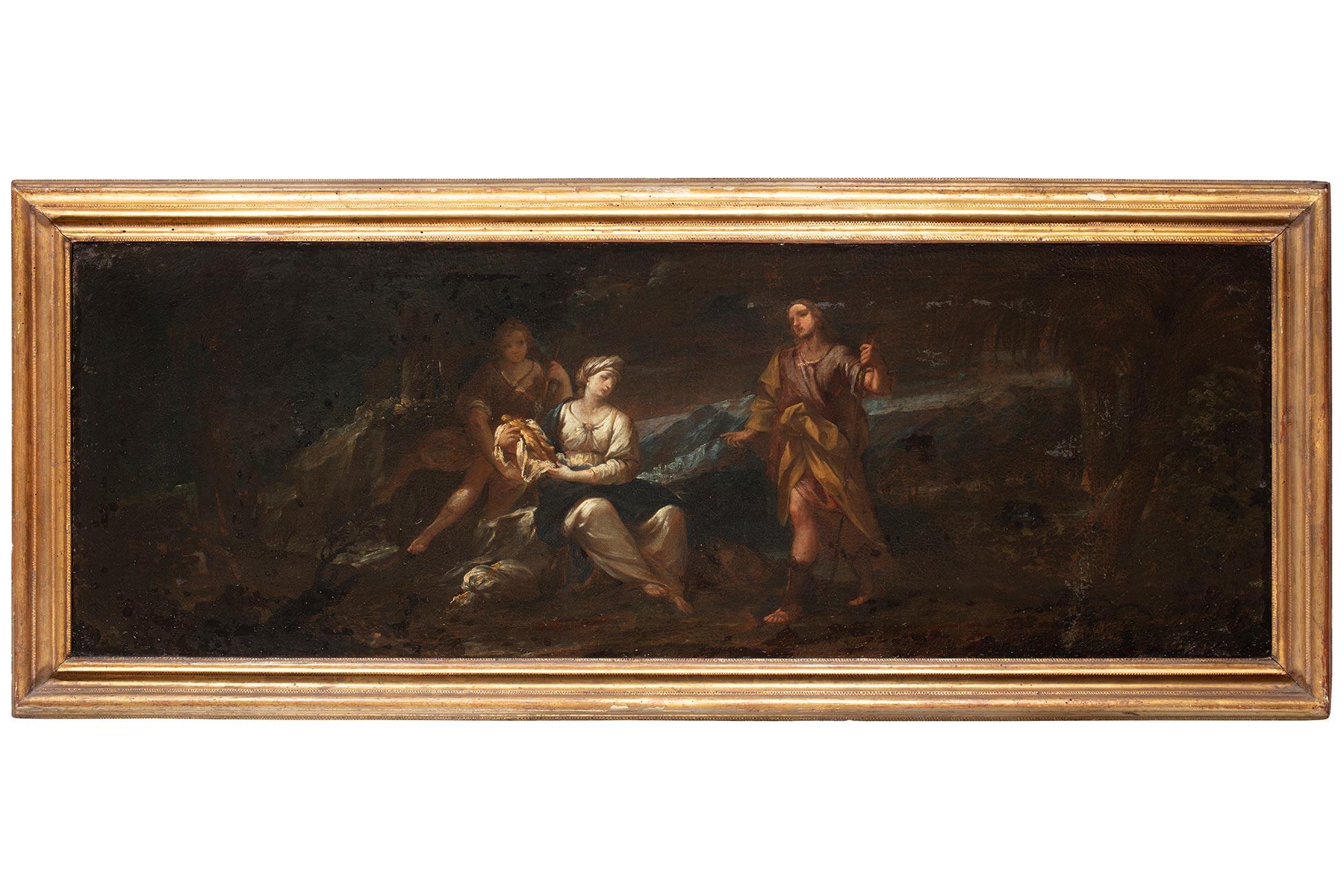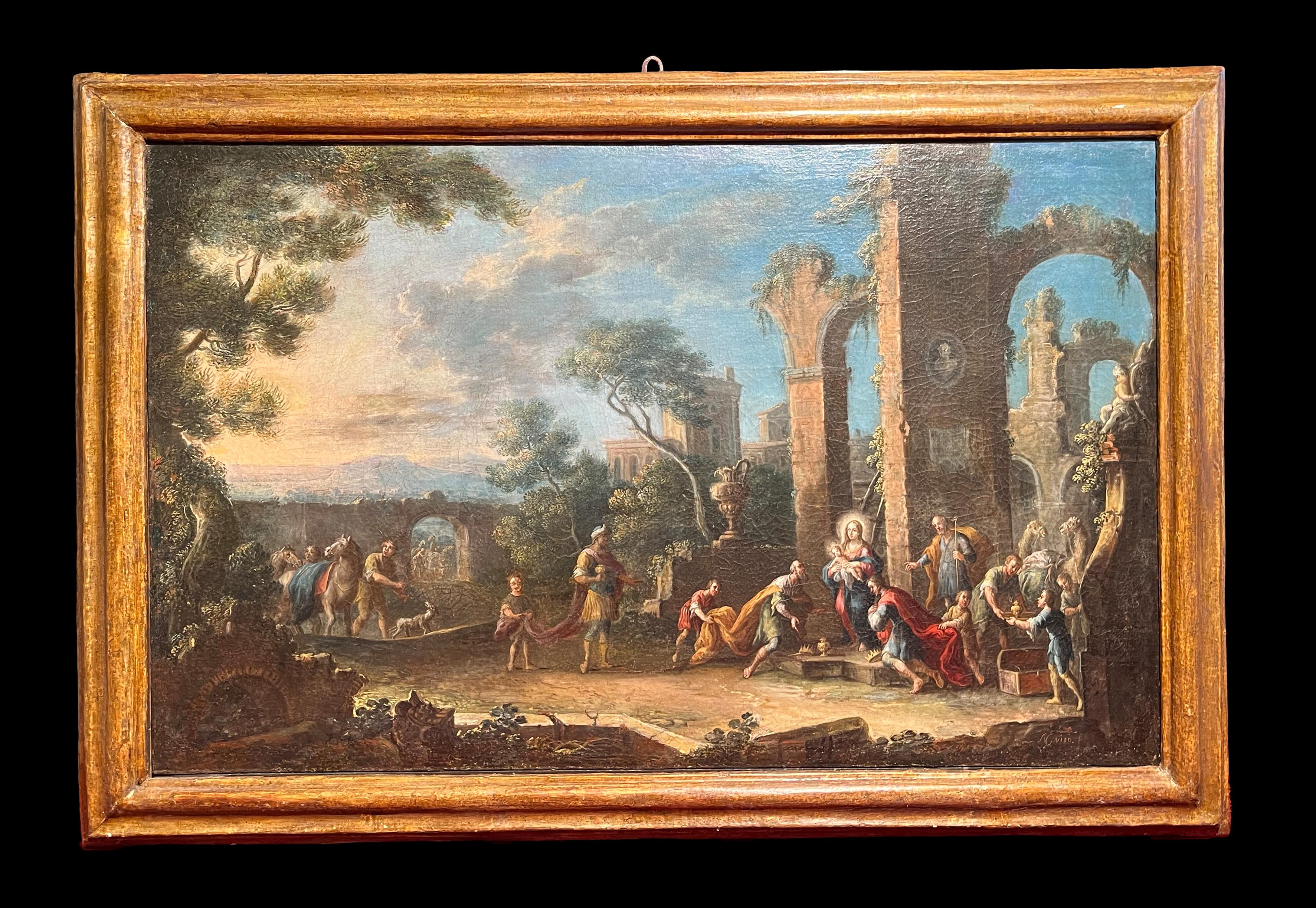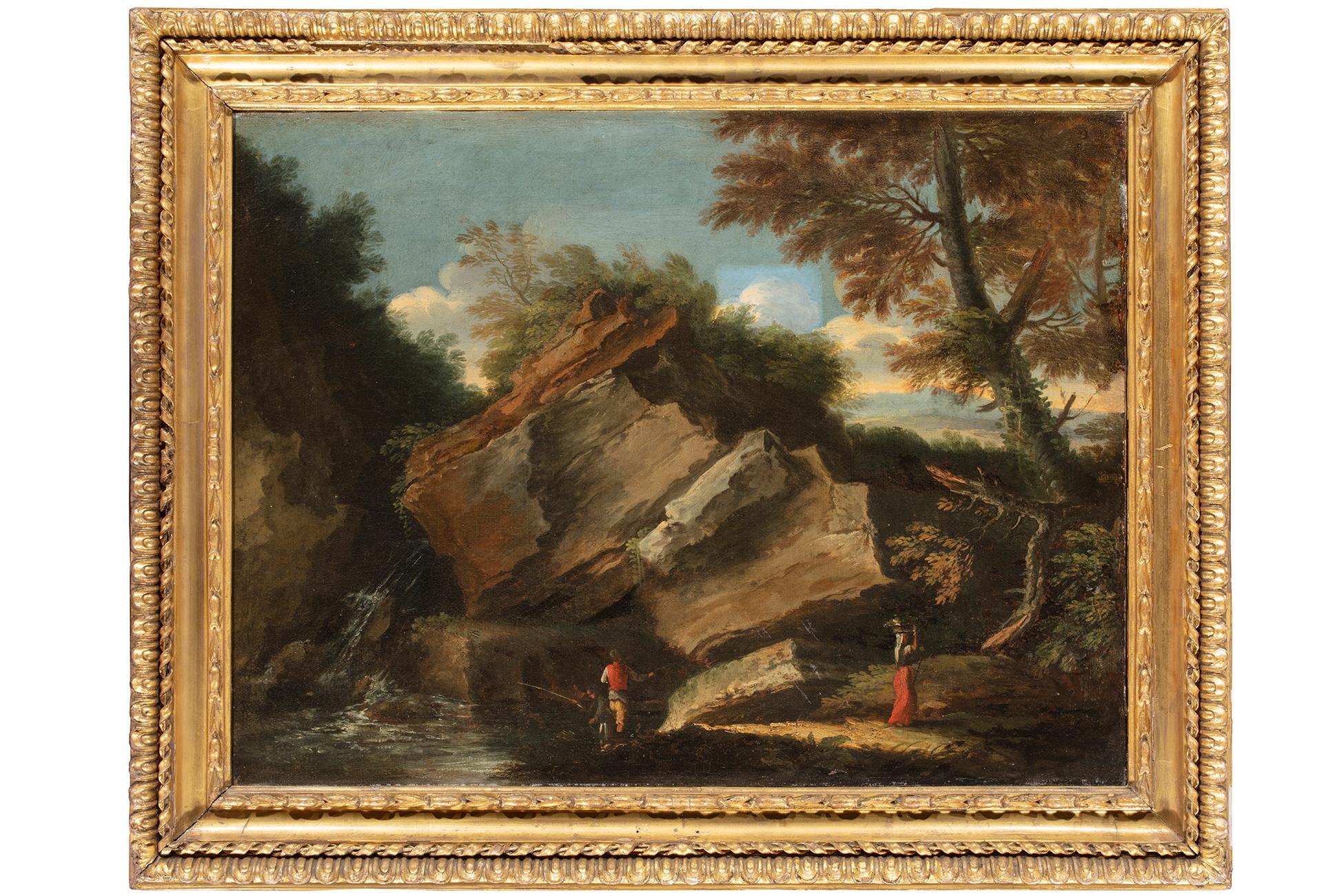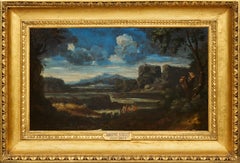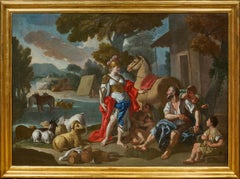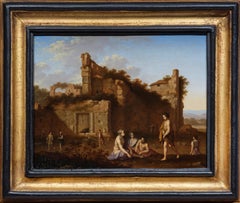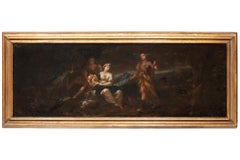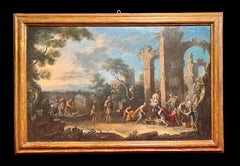Items Similar to Macbeth and the Three Witches a Painting on Panel by Francesco Zuccarelli
Want more images or videos?
Request additional images or videos from the seller
1 of 13
Francesco ZuccarelliMacbeth and the Three Witches a Painting on Panel by Francesco ZuccarelliCirca 1760
Circa 1760
$55,000
£41,773.86
€48,047.57
CA$76,845.78
A$85,691.74
CHF 44,710.30
MX$1,051,469.96
NOK 569,090.85
SEK 539,201.22
DKK 358,596.81
Shipping
Retrieving quote...The 1stDibs Promise:
Authenticity Guarantee,
Money-Back Guarantee,
24-Hour Cancellation
About the Item
This painting, created during Zuccarelli's stay in England, represents the decisive moment when Macbeth, together with Banquo, meets the three witches who announce that he will be King. As the first European painting depicting theatrical characters in a landscape, it is an important testimony to a great artistic and literary current: the beginnings of the Neo-Gothic under the influence of the theory of the sublime.
1. Francesco Zuccarelli
The third of four brothers, Francesco Zuccarelli was born in Pitigliano in southern Tuscany in 1702. His father was from a prosperous family and owned several vineyards and a commerce in cooking utensils and spices near Pisa.
He began his apprenticeship in Rome in the studio of the portraitist Giovanni Maria Morandi (1622 - 1717) and his pupil Pietro Nelli (1672 - 1740), and there he discovered the works of the landscape painters of the preceding century, in particular the work of Claude Gellée known as Le Lorrain (1600 or 1604 - 1682) which would have a major influence on his paintings. After a stay in Florence, it was in Venice, where he arrived in 1732, that he fully devoted himself to landscape painting and joined forces with the painters Bernardo Bellotto and Antonio Visentini. In 1736 he was admitted to the Fraglia dei Pittori, the painters' guild, and in 1736 he enjoyed the patronage of the Marshal von der Schulenburg, the English Consul Joseph Smith and Francesco Algarotti, who recommended him to the Elector of Saxony, Augustus III.
Richard Dalton, the Royal Librarian and Consul Smith persuaded Zuccarelli to travel to England in 1752 following Canaletto. In London, Zuccarelli reached the peak of his art and became friends with members of the English aristocracy, who were particularly sensitive to the Arcadian landscape representations in which Zuccarelli excelled.
He became a member of the Society of the Dilettantes in 1757, and it was in 1760, probably under the influence of the actor David Garrick's interpretation of Macbeth that he completed our painting inspired by scene 3 of Act I where Macbeth meets the three witches with Banquo.
This first English visit, which ended in 1762 with his return to Venice, was followed by a second journey between 1765 and 1771. Zuccarelli finally returned to Venice in 1771 as Director and then President of the Academy of Fine Arts and died in Florence in 1778.
2. The story of Macbeth and description of the painting
Our painting illustrates the crucial moment when Macbeth, represented on the right, leaning on his sword, motionless and imperturbable, accompanied by his friend Banquo, meets the three witches who predict that he will be Lord of Cawdor and King of Scotland.
Devoured by ambition after the fulfilment of this first prophecy, Macbeth, under the influence of his wife, decides to kill King Duncan who is visiting him, and accuses Duncan's sons of the murder. Having become king, Macbeth is racked with guilt and decides to murder all those who become suspicious, starting with Banquo.
The witches reappear and tell him that he will be safe as long as the Birnam forest does not reach his castle at Dunsinane and that only a man not born from a woman can kill him. As the first prophecy is fulfilled, Lady Macbeth, inhabited by remorse, commits suicide. Macbeth marches towards the enemy believing himself invincible before being killed in a duel by Macduff, born by Caesarean section.
In our painting, the group formed by Macbeth, Banquo and the three witches unfolds like an antique frieze in the foreground, while a battle scene in the background on the right evokes the world of noise and fury in which the tragedy is taking place. In a night suddenly lit by a flash of lightning, the witch in white stands out like a ghost, clothes fly in the wind, a horse rears up in battle. The dark sky above the mountains is a metaphorical representation of death lurking around the king, around Macbeth, around every man confronted with his own destiny.
3. Macbeth: neo-gothic taste and theory of the sublime
Michel Levey, in his study devoted to Zuccarelli's British sojourns, underlines the specificity of our painting in the painter's work: an unicum introducing a subject taken from Shakespeare's tragedy within a compositional landscape. This would be the first example in European painting of a representation of a subject taken from a play in a landscape.
The rediscovery of Shakespeare's plays in the mid-eighteenth century in England owes much to the actor David Garrick (1717 - 1779) who made the role of Macbeth, first performed on January 7, 1744 when he was 27 years old, one of his leading roles. Garrick's influence was decisive in finding a way back to the original Shakespearean text preceding the adaptation of the play by D'Avenant, which had been performed until then, and in abandoning contemporary costumes for medieval ones - costumes which are undoubtedly represented in our painting.
In this respect it is interesting to note that the two main characters, Macbeth and Banquo, are dressed in kilts. The wearing of kilts had been banned in Scotland following the Battle of Culloden (16 April 1746) during which the English army, commanded by the Duke of Cumberland, defeated the army of Charles-Edward Stuart (Bonnie Prince Charles). The reintroduction of this traditional attire in our painting probably constitutes a "picturesque" element evoking both the medieval period (as an attribute of an organic society that is disappearing under the pressure of the Enlightenment) but also the exoticism of Scotland.
This rediscovery of the Elizabethan theatre is part of a wider Zeitgeist of rediscovering the arts of the Middle Ages (which will be translated into architecture by the first neo-gothic constructions, the most emblematic of which - Strawberry Hill - was built by Horace Walpole between 1749 and 1776).
The neo-gothic sensibility is fully in line with contemporary philosophical reflections, as expressed in Edmund Burke's 1757 book A Philosophical Enquiry into the Origin of Our Ideas of the Sublime and Beautiful.
This theory of the sublime opposes the sublime with beauty as two exclusive concepts (like light with darkness) while recognising that both can provide pleasure. Sublimity may evoke horror, but the knowledge that the perception is a fiction can be pleasureful. In contrast to classical thinking, Burke argues that ugliness has aesthetic value because of its ability to generate intense emotions, and thereby generate pleasure. Burke also analyses the physiological effects of the sublime, in particular the fear and attraction we may feel when faced with the sublime, which reveals our human finiteness in the face of the grandeur of a nature that surpasses us. This delight that comes from contemplating the sublime is felt even more strongly than the pleasure that comes from contemplating beauty.
in our panel we can find a certain number of elements which take on a particular resonance if we analyse them through the prism of the sublime: the repulsive and abject ugliness of the three witches (one of whom holds a stick around which a snake is wrapped); the grandeur of nature (mountains, waterfall) as the lightning of thunder crosses the sky, and finally the loneliness of the hero Macbeth in the face of the threatening destiny he forsees.
4. The different versions of the artwork
This painting was certainly very much appreciated by the English public, as shown by the fact that there are several versions of it:
• A large pencil sketch is exhibited at Stourhead today;
• A version on canvas, very close to ours and bearing the artist's signature, completed in 1760 was used as a model for William Woollett's engraving in 1770 when the painting was in William Lock's collection; this painting could be the one sold on July 14, 1952 by Christie's (lot 52);
• Another version was signaled at public auction as early as 1761 and came from the collections of Sir William Hamilton; this version was probably resold in 1783, this time on behalf of Charles Hamilton;
• A third panel version is documented in the collections of Grosvernor House in 1821 and was sold by the Duke of Westminster in 1925; this version measuring 81.7 x 147.2 cm is now in the Folger Shakespeare Library in Washington ;
• At least three other versions true to Woollett's engraving exist: one in the Shakespeare Memorial Gallery in Stratford; another in the collections of the Marquis Gondi in Florence; and a third (reproduced by Federica Spadotto) in a private collection.
It should be noted that there is an important difference between our painting and both the version used for the Woollett etching and the Folger Shakespeare Library version. The witch on the left, shown from the front in our painting, seems to be leaning on the stick around which the snake is wrapped and has her left arm raised to hold a veil, whereas in the engraving she is shown three-quarters of the way up, brandishing the stick around which the snake is wrapped, and in the Folger Shakespeare Library version she is also presented from the front but without a veil and with both arms lowered.
5. Provenance
An inscription on the back of our sign "Ante Dineing Room - Lord George Cavendish" tells us the name of the first or one of the very first owners of our panel. In the absence of any further information on the sale of this panel or of any inventory it could have belonged to either :
• Lord George Augustus Cavendish (c. 1727 - 1794). Born in London he was the second son of William Cavendish, the third Duke of Devonshire and his wife Catherine Hoskins. A godson of King George II, he inherited Holker Hall (then in Lancashire, now in Cumbria) in 1753 and replanted its grounds. He became a Member of Parliament in 1751 until his death in 1794; or to his nephew
• George Augustus Henry Cavendish (1754 - 1834), known as Lord George Cavendish until 1831 and then as the Earl of Burlington. Third son of the fourth Duke of Devonshire and his wife Lady Charlotte Boyle, the sole heir to Richard Boyle the third Earl of Burlington, he was also a Member of Parliament from 1775 to 1831. He was the builder of the Burlington Arcade at Piccadilly alongside Burlington House which was purchased from his nephew, the sixth Duke of Devonshire in 1815.
This panel was then exhibited at the Galleria Levi in Milan as part of the exhibition '700 Veneto - paesaggi e Vedute' in November 1967 before joining a private Italian collection.
6. Conclusion: our opinion on the artwork
All hail, Macbeth ! that shalt be king hereafter. (Shakespeare - Macbeth scène 3 acte I).
Zuccarelli's quivering touch expresses all the emotions of this decisive meeting with the three witches during which Macbeth's life is irremediably turned upside down. Beyond the strength of the narrative, our panel is a rare testimony to the birth, in the heart of 18th century English cosmopolitan society, of a new sensibility, from which Romanticism would flourish in the following century.
Main bibliographical references :
Michael Levey Francesco Zuccarelli in England Italian Studies XIV 1959 (pp 6-8 fig. I)
Mercedes Precerutti Garberi '700 Veneto - Paesaggi et Vedute Exhibition catalogue, Milan, Galleria Levi 1967 (pp8-9, n. 1, fig. 1)
Federica Spadotto Francesco Zuccarelli in England Cierre Grafica 2016 (pp 35-39 fig. 27)
George Winchester Stone, Jr. Garrick's Handling of "Macbeth" - Studies in Philology Vol. 38, No. 4 (Oct., 1941), pp. 609-628 (20 pages) - University of North Carolina Press
- Creator:Francesco Zuccarelli (1702 - 1788, Italian)
- Creation Year:Circa 1760
- Dimensions:Height: 17.33 in (44 cm)Width: 22.05 in (56 cm)
- Medium:
- Movement & Style:
- Period:1760-1769
- Condition:Oil on mahogany panel 33 x 44.5 cm (44 x 56 cm framed) Inscription on the back: "Ante Dineing Room - Lord George Cavendish" This painting has been restored - a condition report is available upon request.
- Gallery Location:PARIS, FR
- Reference Number:1stDibs: LU156828245132
About the Seller
5.0
Vetted Professional Seller
Every seller passes strict standards for authenticity and reliability
Established in 2020
1stDibs seller since 2021
10 sales on 1stDibs
Typical response time: 2 hours
- ShippingRetrieving quote...Shipping from: PARIS, France
- Return Policy
Authenticity Guarantee
In the unlikely event there’s an issue with an item’s authenticity, contact us within 1 year for a full refund. DetailsMoney-Back Guarantee
If your item is not as described, is damaged in transit, or does not arrive, contact us within 7 days for a full refund. Details24-Hour Cancellation
You have a 24-hour grace period in which to reconsider your purchase, with no questions asked.Vetted Professional Sellers
Our world-class sellers must adhere to strict standards for service and quality, maintaining the integrity of our listings.Price-Match Guarantee
If you find that a seller listed the same item for a lower price elsewhere, we’ll match it.Trusted Global Delivery
Our best-in-class carrier network provides specialized shipping options worldwide, including custom delivery.More From This Seller
View AllItalian Landscape with Jack Players, a painting by Gaspard Dughet (1615 - 1675)
By Gaspard Dughet
Located in PARIS, FR
Here Gaspard Dughet offers us an idyllic vision of the Roman countryside. The stages follow one another in a perfectly structured composition, revealing here a lake, there travellers walking along, gradually leading our eye to the blue horizon. But behind its classical composition, this landscape is particularly interesting because of three anthropomorphic details that the artist has hidden, opening the way to a radically different interpretation...
1. Gaspard Dughet, a landscape artist in the light of Poussin
Gaspard Dughet was born on June 4th, 1615 in Rome where his father, of French origin, was a pastry cook. He was probably named Gaspard in honour of his godfather Baron Gaspard de Morant, who was, or may have been, his father's employer. His older sister Jeanne married the painter Nicolas Poussin (1594 - 1655) on September 1st, 1630. The young Gaspard was apprenticed with his brother-in-law at the beginning of 1631, which led his entourage to name him Gaspard Poussin. The first preserved works of the painter date from the years 1633-1634 and were painted in Poussin’s studio.
Around 1635, Gaspard Dughet became emancipated and began to frequent the Bamboccianti circle. In 1636, he became friends with the painter Jean Miel (1599 - 1656), but also with Pier Francesco Mola (1612 - 1666) and Pietro da Cortona (1596 - 1669).
This was also the time of his first trips throughout Italy. The painter, although of French origin, appears never to have visited France. In 1646 he settled permanently in Rome. A recognized painter with a solid book of orders, he remained faithful to landscape painting throughout his life, alternating between cabinet paintings and large decorative commissions, using both oil and fresco.
Nailed to his bed by rheumatic fever at the age of 58, he died on May 25, 1675.
2. Discovering an idealized landscape
Beyond a relatively dark foreground that takes us into the landscape, we discover a vast bluish horizon: a plateau surrounded by deep ravines advances to the right, overhanging an expanse of water that sparkles below. A road winds through a mountainous mass as if leading us to the fortress that crowns it; another town appears in the distance at the foot of three conical mountains.
The composition is rigorous, mineral, and structured by geometric volumes. The various stages in the landscape lead one to the next attracting the eye towards the horizon located in the middle of the canvas. The general impression is that of a welcoming and serene nature.
In many places the paint layer has shrunk, or become transparent, revealing the dark red preparation with which the canvas was covered and accentuating the contrasts.
Human presence is limited to three jack players, leaning against a mound in the foreground. Their long garments, which may evoke Roman togas, contribute to the timelessness of the scene.
Close examination of the canvas reveals two other travellers on the path winding between the rocks. Made tiny by the distance, their introduction in the middle register, typical of Dughet's art, lengthens the perspective.
While it is difficult to date the work of a painter who devoted his entire life to the representation of landscapes, it is certain that this painting is a work from his later years. The trees that occupied the foreground of his youthful compositions have been relegated to the sides, a stretch of water separates us from the arid mountains counterbalanced by two trees represented on the opposite bank. The introduction of this stretch of water in the middle of the landscape betrays the influence of the Bolognese and in particular of the Dominiquin (1581 - 1641)
A number of similarities with a drawing in the British Museum might suggest a date around 1656-1657, since, according to Marie-Nicole Boisclair , it has been compared with the Prado's Landscape with the Repentant Magdalene, painted at that period.
3. Three amazing anthropomorphic details
While some late Renaissance landscapes offer a radical double reading, allowing one to see both a face or a human body behind the representation of a landscape, it seems interesting to us to hypothesize that Gaspard Dughet had fun here by slipping in a few details that, taken in isolation, evoke human or animal figures.
We will give three examples, looking closely at a cloud, the trunk of a broken tree and the top of a cliff.
The main cloud could thus evoke a Christ-like face or that of an antique god...
Category
1650s Old Masters Landscape Paintings
Materials
Oil
Erminia and the Shepherds, a painting by Francesco de Mura (Napoli 1696 - 1782)
By Francesco de Mura
Located in PARIS, FR
In this masterly painting, Francesco de Mura presents the meeting of Erminia and the shepherds, a famous episode taken from the seventh canto of Torquato Tasso's Jerusalem Delivered....
Category
1760s Old Masters Figurative Paintings
Materials
Canvas, Oil
Diana and Actaeon, a Mannerist painting after Joseph Heintz the Elder
Located in PARIS, FR
This painting seduced us with its rich colors. Depicting Diana and her companions surprised by Actaeon, it was inspired by an engraving by Aegidius Sadeler II after a painting by Jos...
Category
17th Century Old Masters Nude Paintings
Materials
Oil, Wood Panel
Gathering in antique Ruins, a monogrammed painting by Jan van Haensbergen
By Jan Van Haensbergen
Located in PARIS, FR
Jan van Haensbergen was a painter of the Dutch Golden Age and a pupil of Cornelius van Poelenburgh (Utrecht 1594 - 1667). The painting we are presenting is inspired by Poelenburgh’s landscapes from his Italian sojourn. The dreamlike atmosphere of this Gathering in antique ruins appealed to us. Against a backdrop of antique ruins, three draped characters (perhaps bathers) are sitting in a circle, greeting a fourth character walking towards them.
Their tranquility contrasts with the bustle of the other characters in the background. They constitute a vivid illustration of otium, this leisure time that allows us to realize our full potential. With this Arcadian landscape, Jan van Haensbergen invites us in turn to leave the hustle and bustle of everyday life behind, to take a break, to enjoy the present moment chatting with close friends…
1. Jan van Haensbergen, a landscape and portrait painter of the Dutch Golden Age
Jan van Haensbergen was born in 1642 in Gorinchem, a town in southern Holland to the east of Rotterdam. He was a pupil of Cornelius van Poelenburgh, and began by painting landscapes inspired by those of his master, in an Italianate style. Between 1668 and 1669, he was registered at the Guild of Saint Luke in Utrecht.
In 1669, he moved to The Hague, where he joined the Confrérie Pictura, an artist society founded in 1656. His portraits, which became his main activity as a painter after settling in The Hague, were strongly influenced by Caspar Netscher (Prague or Heidelberg 1639 - The Hague 1684), whom he met in The Hague and whose son Constantijn became his son-in-law by marrying his daughter Magdalena.
In addition to his work as an artist, Van Haensbergen was also an art dealer, probably helped by his appointment as Dean of the Confrérie Pictura, where he also teached.
2. Description of the artwork and related paintings
This painting seems to us to be a kind of allegory of otium, that quiet bliss promised by Epicurus. It might even evoke an Epicurean proverb: "It is better to lie on the naked ground and be at ease, than to have a golden carriage and a rich table and be worried" .
Three draped young people - two men and a woman in the background - are seated in a circle, greeting a fourth figure walking towards them, hair disheveled and body draped in a towel as if drying off after a bath, indicating the need for prior purification to fully enjoy this rest. Their nonchalance contrasts with the bustle of the various characters in the background.
The composition is punctuated by successive diagonals, and opens onto a landscape on the right, with a succession of mountainous planes. This painting is typical of the Italianate works produced by Van Haensbergen in the 1660s under the influence of Cornelis van Poelenburgh...
Category
17th Century Old Masters Landscape Paintings
Materials
Oak, Oil
River Landscape with Shepherds and Architecture, a painting by Jan van Bunnik
By Jan van Bunnik
Located in PARIS, FR
This painting has been the subject of a study by the art historian Fabrizio Dassie (available on request), confirming its inclusion in Jan van Bunnik’s corpus.
In this painting, Ja...
Category
Late 17th Century Old Masters Landscape Paintings
Materials
Copper
Stag Hunting in the Vicinity of Nuremberg by a German Artist Peter von Bemmel
Located in PARIS, FR
This small landscape shows a hunting scene: two riders are chasing a stag with their dogs at the edge of a forest. Signed by Peter von Bemmel, it is typical of the production of this...
Category
1720s Old Masters Landscape Paintings
Materials
Copper
You May Also Like
17th Century by Felice Torelli Rachel Hiding the Idols Oil on Canvas
Located in Milano, Lombardia
Felice Torelli (Verona, Italy, 1667 - Bologna, Italy, 1748)
Title: Rachel Hiding the Idols
Medium: Oil on canvas
Dimensions: without frame 41 x 116 cm -...
Category
Late 17th Century Old Masters Landscape Paintings
Materials
Canvas, Oil, Cotton Canvas
Landscape with Merchants Arranging the Goods - Oil Paint - Late 17th Century
Located in Roma, IT
Oil on canvas attributed to Philipp Peter Roos Rosa da Tivoli, realized in the late 17th Century in Italy.
Large work with very fine workmanship, in particular in the creation of an...
Category
Late 17th Century Baroque Figurative Paintings
Materials
Oil
18th Century by Nicola Viso The adoration of the magi Oil on canvas
Located in Milano, Lombardia
Nicola Viso, (active 1724 – 1742)
Title: The adoration of the magi
Medium: Oil on canvas
Dimensions: without frame 63 x 100 cm – with frame 76.5 x 114.7 x 4.5 cm
Signed “N. Viso. f” ...
Category
18th Century Old Masters Figurative Paintings
Materials
Canvas, Oil
Francesco Zuccarelli Venetian master - 18th century landscape painting - Knights
By Francesco Zuccarelli
Located in Varmo, IT
Francesco Zuccarelli (Pitigliano 1702 - Florence 1788) - River landscape with knights and medieval village.
53 x 70 cm without frame, 64.5 x 80.5 cm with frame.
Antique oil paintin...
Category
Mid-18th Century Rococo Landscape Paintings
Materials
Canvas, Oil
$17,864 Sale Price
31% Off
Free Shipping
17th Century by Pietro Montanini Landscape Oil on Canvas
Located in Milano, Lombardia
PIETRO MONTANINI (Perugia, Italy, 1619 - 1689)
Title: Landscape
Medium: Oil on canvas
Dimensions: without frame 50 x 65 cm - with frame 64 x 79 cm
An...
Category
17th Century Old Masters Landscape Paintings
Materials
Canvas, Cotton Canvas, Oil
$10,099 Sale Price
22% Off
Warrior Figures Conversating in Capriccio Landscape 17-18 Century Oil Painting
Located in Stockholm, SE
In the foreground, we see two conquistadors and three natives accompanying them landing on the shore, presumably on a reconnaissance mission in an unfamiliar bay. Perhaps they are in...
Category
1690s Baroque Landscape Paintings
Materials
Canvas, Wood, Oil
More Ways To Browse
Four Panel Painting
Large Italian Wood Panels
Old Masters Paintings Of Venice
English Landscape Etching
Medieval Panel
Woman With A Veil
Italian Painting 1600
King George Ii
Antique Wood Book Stand
Sword In The Stone
Horse Pencil Sketches
Old Utensils
Hamilton Engravings
George Washington Engraving
Old Spice
Black Forest Horse
Snake Engraving
E Hamilton
